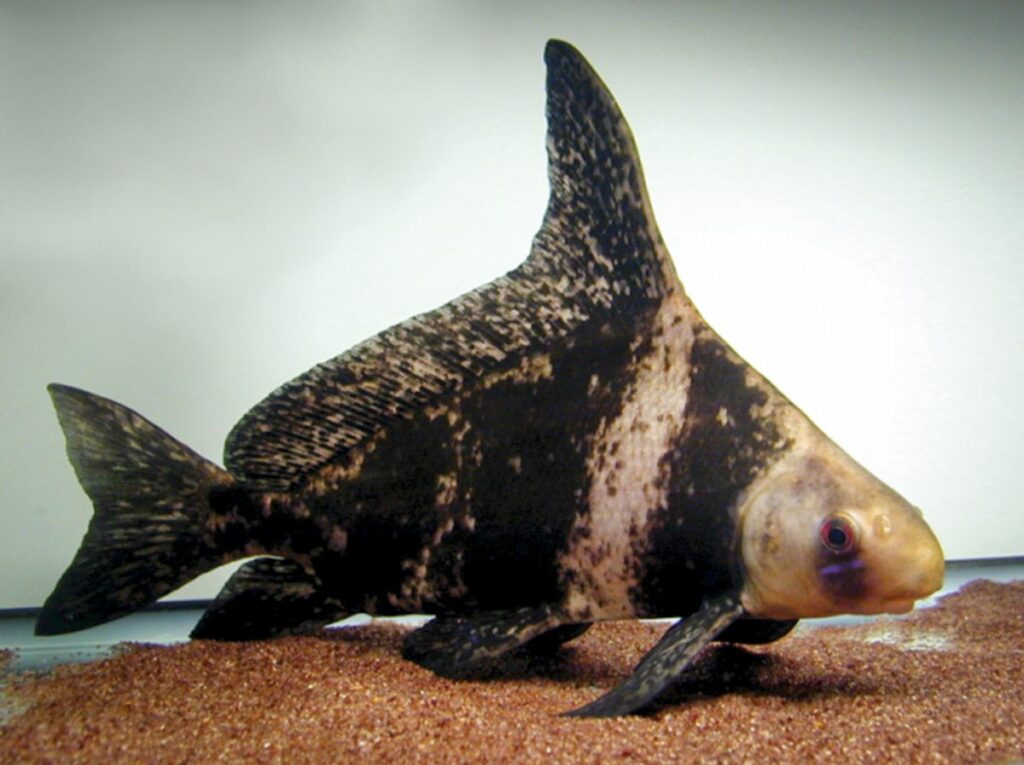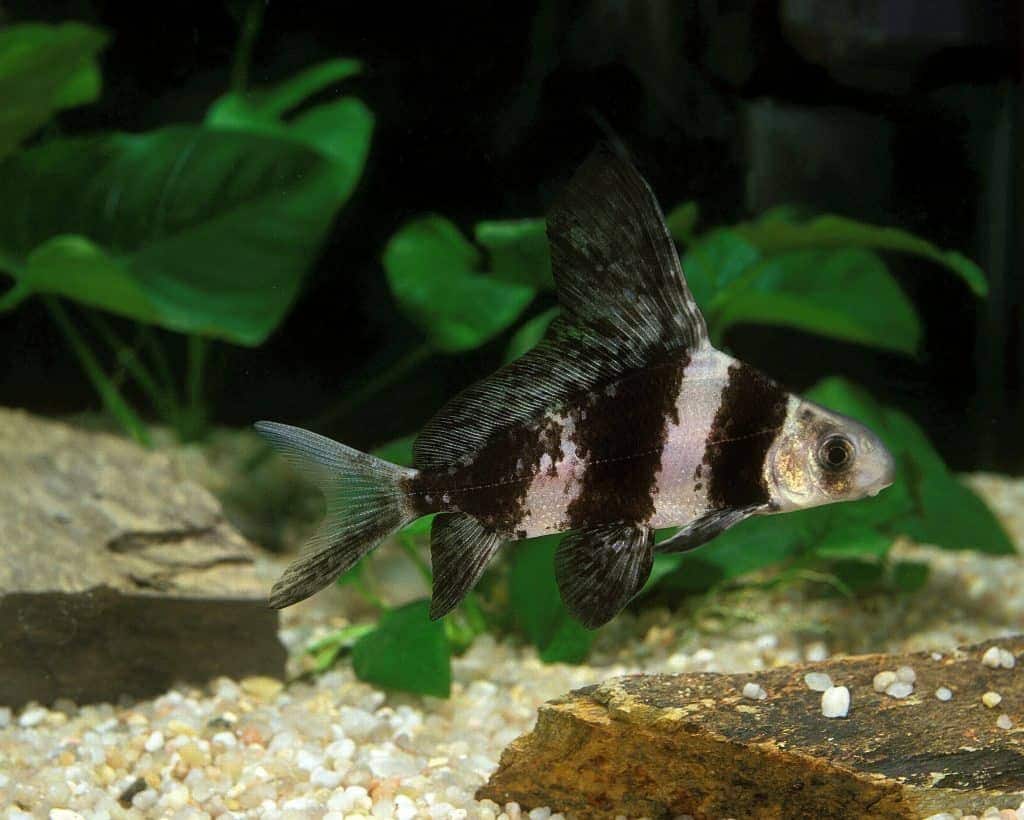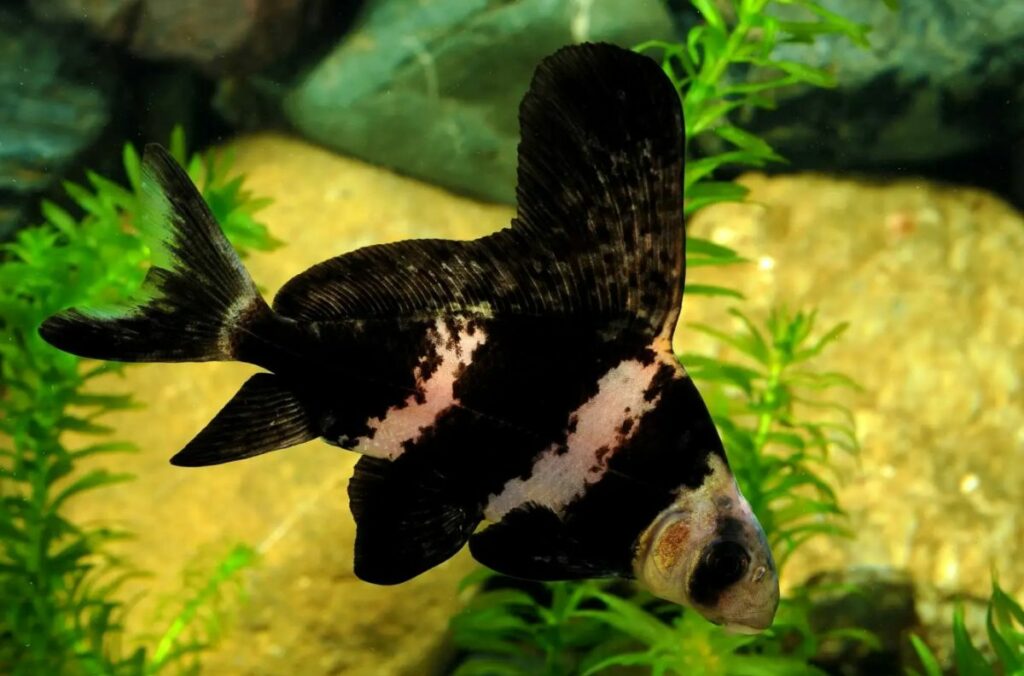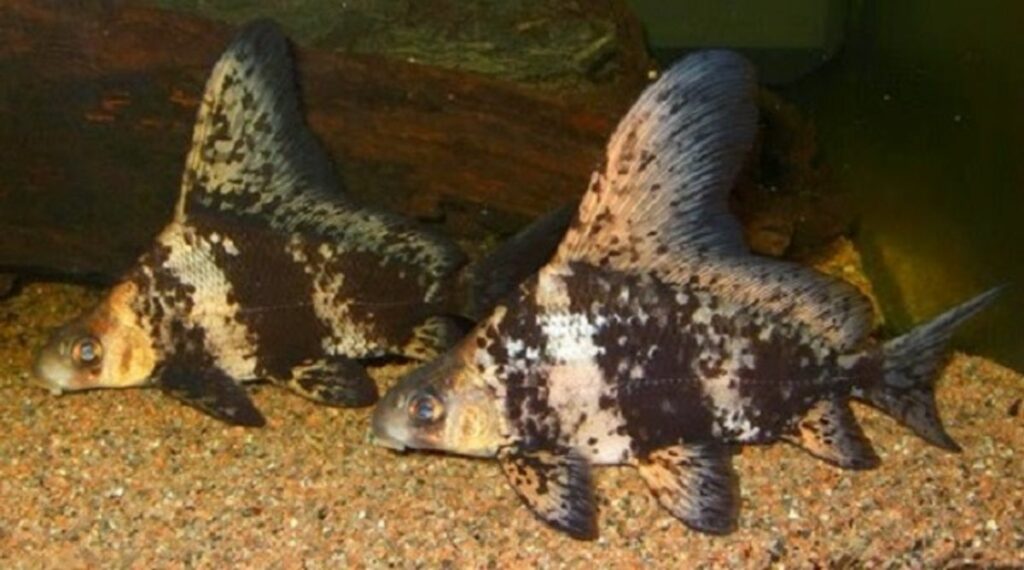The Chinese high fin shark is no true shark. Like several popular freshwater fish, it has a shark-like appearance. Their bold chocolate and pink bands make hi fin sharks even more interesting. But is it a good choice for the average home aquarium?

What is the Chinese High Fin Shark?
The Chinese high fin shark has a lot of common names. You will see them listed for sale as banded sharks, banded suckers, sailfin suckers, chinese banded loach, and other variations.
They are members of the family Catostomidae (suckers), which are close relatives of true carp like goldfish and koi. Suckers are similar in habits to plecostomus and other sucker catfish. They are bottom dwellers that feed on algae, aquatic invertebrates, and plants.
Suckers are all found in North America, except for the longnose sucker (Alaska + Russia) and the Chinese high fin shark.
Hi fin sharks live in the Yangtze River Basin. They are endangered in their home region due to pollution, dams, overfishing, and competition from invasive species.
Chinese high fin sharks are always sold when young because that’s the one time they will ever fit inside of a fish tank. Adults grow just over 4 feet long. So unless you have an aquarium larger than 500 gallons, an outdoor pond is your only option.
Young banded sharks are very shark-like, with their dorsal fin standing tall along their backs. But as they grow up, banded hi fin sharks lose both the bands and the high fin.
The adult fish is a dark brown torpedo-shaped sucker. They are peaceful, however, and help keep ponds free from green hair algae.
- Common Names: Chinese High Fin Shark, Banded Shark, Banded Sucker
- Scientific Name: Myxocyprinus asiaticus
- Origin: Yangtze River Basin, China
- Length: 4 feet
- Aquarium Size: 500+ gallons or outdoor pond
- Temperament: Peaceful
- Ease of Care: Moderate
Chinese High Fin Shark Care
The Chinese banded shark gets a care rating of “moderate” because it grows so large. They are beautiful when young and easy to keep. But you need to be able to house a fish that weighs 50+ lbs when full grown.

China Shark Tank Size
You sometimes see banded sharks for sale even in major pet stores like PetSmart. But these fish should only be kept by outdoor pond keepers. A young hi fin shark will live in an unheated 30 gallon aquarium. But you will need to upgrade within a year. And again a year after that.
A full size Chinese high fin shark needs a pond of 1,000 gallons or more. The depth of your pond is also important. These are temperate zone fish. So even when a pond freezes over they will overwinter like koi and goldfish do.
But a pond in a freeze zone needs to be at least 3 to 5 feet deep, depending on your local climate. Otherwise the fish will be too close to the ice that forms, which may kill them.
A pond de-icer should also be used to keep a hole open in the ice for gas exchange. Once a pond has frozen over it can’t release carbon dioxide or take in fresh oxygen.
Water Conditions for Banded High Fin Sharks
Chinese high finned banded sharks are not picky when it comes to water conditions. Except for one parameter: they are not tropical fish. Even pet stores aren’t always aware of this. Almost every banded shark I see in pet stores lives right beside platies and angelfish in 75-80℉ water.
Tropical conditions will kill a Chinese high fin shark. If you’re serious about keeping one alive, then don’t use a heater. These are cold water fish; water temperatures of 55-68℉ are crucial.
If you live in a warm climate, a basic fan-operated aquarium chiller will bring the temperature down by 4-5℉. Electric chillers will cool the tank further but they cost quite a bit more.
Chinese high fin sharks are not very sensitive to ammonia; they are as hardy as goldfish and koi. But take care not to allow levels to stay elevated for too long. Nitrogenous waste products are always dangerous, even to hardy fish.
Oxygen levels need to be high as well. Which is another reason why tropical aquariums are fatal to this species: warm water holds less oxygen. Using an aquarium aerator will provide even better conditions for your shark.
The pH should be neutral to alkaline (pH 7.0-8.0). Chinese banded sharks are also unfussy when it comes to water hardness. Since they come from mountain streams and rivers, they are used to the minerals found in most tap water.

What Do Chinese Hi Fin Banded Sharks Eat?
Chinese hi fin banded sharks are omnivorous and easy to feed. They accept flakes and small pellets when young.
As they grow up, pond fish pellets should be the base of their diet. If you offer sinking sticks or wafers it will be easier for these bottom feeders to not be out-competed by their pond mates.
Fresh organic matter also needs to be a regular part of their diet. Green hair algae is a favorite food of the banded shark.
Soft coldwater plants like anacharis will also be picked apart. But if your pond or aquarium has large, well established bunches of it growing the shark will not be able to eat all of it.
Small invertebrates are another important part of their diet. Chinese hi fin sharks eat small snails, worms, insect larvae, shrimp, and other bottom dwellers.
Even large apple snails are not safe from them. Only add snails to your pond if you’re okay with them being a source of food.
Chinese High Fin Shark Pond Mates
Hi fin sharks are very large fish but they are also peaceful. Any fish that is also peaceful and enjoys unheated water is a possible tank mate for them. Goldfish and koi are the most popular choices.
They are brighter in color than the muddy brown of an adult hi fin shark. Goldfish and koi also come up to the surface, which adds further visual interest to the pond.
Dojo loaches are much smaller but also compatible with hi fin sharks. You may even keep large schools of gambusia (mosquito fish).
These little livebearers are close relatives of guppies and will eat any mosquito larvae that hatch in your pond. Since they are from North America, mosquito fish are winter hardy. Guppies are also good mosquito control for outdoor ponds. But only in warmer places like Florida.
Don’t add any invertebrates like crayfish or snails unless they are meant to be food for your hi fin shark.
When younger, Chinese banded sharks will live in unheated aquariums with other cold water (or cold tolerant) fish. Guppies, rosy barbs, and zebra danios are just a few options for a coldwater fish tank.
Breeding the Chinese High Finned Banded Shark

Chinese hi fin sharks are bred in captivity in China as food fish. A few of these fish are purchased from wholesalers for the pet industry.
Unless you have several full size Chinese high fin sharks and a big outdoor pond, you aren’t going to succeed. River species are often migratory and even respond to seasonal cues to spawn.
Hormonal treatments are also normal in Asia to “force” the fish to spawn. There are no records of these fish being bred by aquarists or pond hobbyists.
Conclusion
As a baby, the Chinese high fin shark is a cute and unique looking aquarium fish. But the older it gets the less cute it becomes and the more space it needs. That said, adult banded sharks are peaceful pond inhabitants and excellent algae eaters.
FAQs
Chinese banded sharks are uncommon in pet stores but not impossible to find. Most specialty aquarium stores will be able to special order one. Online fish stores and auction websites offer even more possibilities. Expect to pay $30-80 for a young hi fin banded shark. Adults aren’t offered for sale because they are too large and not as beautiful.
High finned banded sharks will reach 4 feet long as an adult. The heaviest recorded specimen weighed 88 lbs. These are only possible to keep in aquariums when very young. Unless you have a custom-designed fish tank larger than 500 gallons, hi fin sharks should be kept in outdoor ponds.

